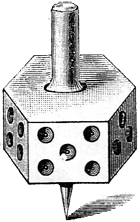
|
foreword to the online edition I. introductory II. common sharpers and their tricks III. marked cards and the manner of their employment IV. reflectors V. holdouts VI. manipulation VIII. the game of faro IX. prepared cards X. dice XI. high ball poker XII. roulette and allied games XIII. sporting houses XIV. sharps and flats
|
SHARPS AND FLATS
CHAPTER X DICE
Dice TopsBefore concluding the present chapter, it behoves us to attend, for a moment, to the methods of falsification connected with that well-known little device, the 'dice-top' or 'teetotum.' It deserves just a slight mention, although the fact that it is not of great importance is evidenced by the very terse reference made to it in the various catalogues. This is what one of them says upon the subject:
From even this scanty information, however, we may gather two things. Firstly, that the top can be made to fall either high or low, as required consequently there is some trick in it; and, secondly, that the trick, whatever it may be, does not depend upon the material of which the top is made, since black walnut is just as good as ivory. Better, in fact, because cheaper. The little instrument itself is shown in the adjoining illustration.
Here then we have a little hexagonal top, with dice-spots upon its sides. It is spun with the thumb and ringer, and the number of spots which fall uppermost in the genuine article, at the time of its funning down, depends entirely upon chance. Not so, however, with the tops advertised as above. They can be made to fall in any desired manner. The spindle, instead of being fixed, as it should be, can be turned round within the body of the top. Attached to one side of the spindle, within the top, and revolving when the spindle is turned, there is a small weight which can be set to face either of the sides. The side opposite which the weight is allowed to remain is the one which will lie upon the table when the top comes to rest. These teetotums are largely used in the States to 'spin for drinks,' and a very favorite way of working them is as follows. A man will enter some bar whilst the barkeeper is alone, custom being slack. He produces one of the little articles referred to, and having initiated the bar-keeper into its capabilities, induces him to purchase it. In all probability the bar-keeper sets to work with his new toy, and wins many a drink in the course of the next few weeks. After awhile, however, two accomplices of the man who 'traded' the top will present themselves at the bar, pretending to be more or less intoxicated. Naturally, the bar-keeper thinks he has a safe thing, and tries the dice-top upon them. They lose a few bets, then pretend to lose their temper, and want to bet heavily upon the results given by the top. To this, of course, their dupe has not the least objection; he is only too ready to fall in with their views. But in the meantime, one of them, under pretence of examining the top slightly, contrives to ring in another of exactly similar appearance, but which is set to fall low when the spindle is turned to face in the same direction as that given to the other when intended to throw high. The bar-keeper thus falls an easy victim to the snare. Turn the spindle as he may, the top absolutely refuses to fall in the direction he requires.
This, then, exhausts all we have to consider with reference to dice and their manipulation. If we have not learnt very much in this branch of the art of cheating, it is because there is not very much to learn. Simple as the devices are in this kind of sharping, they are largely utilized, even at the present day, and notwithstanding the fact that 'palming' and kindred methods of concealing small articles are so generally understood. The great point in the sharp's favor, in this as in all other manipulations, is that his dupes are not expecting trickery, and consequently do not look for it. It is highly probable that as much money has changed hands over games of dice as in connection with any other form of gambling, horse-racing, perhaps, excepted. Years ago, of course, the dice-box was a much more familiar object than at the present day; still even now it flourishes with undiminished vitality in many parts of the world. Well, those who deal with the dice will always pay dearly for experience, which may be bought too dearly sometimes. Caveat emptor.
|
| « dice (hazard) | high ball poker » |
home | introduction | book content | links | advertising | contact
